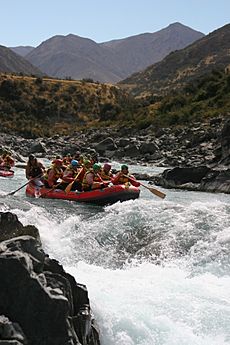Rangitata River facts for kids

The Rangitata River is a famous river in New Zealand. It is one of the special braided rivers that helped create the Canterbury Plains in the South Island. The river flows southeast for about 120 kilometers (75 miles) from the high Southern Alps. It then empties into the Pacific Ocean about 30 kilometers (19 miles) northeast of Timaru.
The name "Rangitata" comes from the Māori people. It has a few meanings, like "day of lowering clouds," "close sky," or "the side of the sky."
Contents
Rangitata River and Movie Magic
The Rangitata Valley is a beautiful area in the middle of the Southern Alps. This valley became a famous movie set! The scenes for the city of Edoras in The Lord of the Rings: The Two Towers and The Return of the King were filmed here. You can find this movie magic spot on and around a place called Mount Sunday.
Early Settlers and Sheep Farms
Near Mount Sunday, there are some remote sheep farms. These include places like Mesopotamia, Mt Potts, and Erewhon. The name Erewhon was given by Samuel Butler. He was the first European settler to live at the Mesopotamia sheep station. Butler also wrote a book called Erewhon in 1872.
How the River Helps People
Before the Rangitata River reaches the Canterbury Plains, it flows through a narrow area called the Rangitata Gorge. Here, some of its water is taken out to help people. This water goes into the Rangitata Diversion Race (RDR).
Water for Farms and Power
The RDR is a special channel built between 1937 and 1944. It helps bring water to farms for irrigation. This means it waters crops so they can grow. The RDR also helps make electricity! It supplies water to power stations like Montalto and Highbank.
Protecting Fish in the River
At the start of the RDR, there is New Zealand's first "acoustic fish fence." This fence uses sound to keep young salmon, called smolt, in the river. It stops them from swimming into the irrigation channels and ending up on farmland.
There is also another irrigation system called the Rangitata South Irrigation Scheme. This system uses a special screen to protect fish. It sends water to seven large man-made dams. These dams hold a lot of water, about 18,000,000 cubic meters (635 million cubic feet). This water then helps irrigate 16,000 hectares (39,500 acres) of land that used to be very dry. This system even has a special section for fish to lay their eggs. This helps increase the number of fish for people who like to fish for sport.
Changes to the River's Path
Near its mouth, the Rangitata River used to split into two streams. This created a large island called Rangitata Island. Important roads and railways crossed this island. However, the southern branch of the river has since been blocked. The land there is now used for farming. While it's still a flood plain, water doesn't usually flow there anymore.
Fishing in the Rangitata River
The Rangitata River is a very popular place for fishing in the Central South Island. It has a strong population of Chinook salmon. About 75 percent of the fishing activity on the river is for salmon. People also fish for brown trout, rainbow trout, and brook char here.
In 1999, a group called Fish and Game New Zealand asked for a special order to protect the Rangitata River's water. This "water conservation order" was officially put in place in 2006.
Train Derailment
On December 23, 1999, Fish and Game New Zealand asked for a special order to protect the Rangitata River's water. This "water conservation order" was officially put in place in June 2006.
On January 4, 2002, a train engine, DC 4686, ended up completely underwater in the river. This happened because floodwater washed away the ground supporting the railway line, causing the train to go off the tracks.

